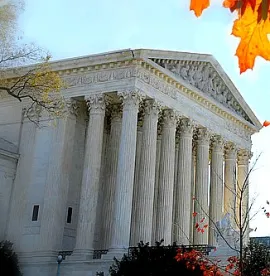Through a splintered set of opinions, the Supreme Court of the United States held that appointment of administrative patent judges (APJs) serving on the Patent Trial and Appeal Board (PTAB) violated the Appointments Clause of the Constitution, and the proper remedy was to vest the US Patent and Trademark Office (PTO) Director (Director) with discretion to overturn the PTAB’s decisions. United States v. Arthrex, Inc., Case Nos. 19–1434; –1452; –1458 (June 21, 2021). Chief Justice John Roberts delivered the opinion of the Court, with opinions by Justice Neil Gorsuch (concurring in part and dissenting in part), Justice Stephen Breyer (concurring in part in the judgment and dissenting in part) and Justice Clarence Thomas (dissenting).
IN DEPTH
BACKGROUND
Arthrex, a medical device company, appealed an inter partes review (IPR) decision holding that prior art anticipated its patent. On appeal, Arthrex argued that the appointment of the PTAB judges by the US Secretary of Commerce—rather than by the President of the United States with US Senate confirmation—violated the Appointments Clause. Under the Appointments Clause, principal officers must be appointed by the President and confirmed by the Senate whereas inferior officers may be appointed by a department head (like the Secretary of Commerce). Thus, the issue was whether PTAB judges were inferior or principal officers.
On appeal at the Federal Circuit, the panel held that the inability of the Director to review the PTAB judges’ decisions, combined with the for-cause limitation on the Director’s removal authority, rendered the PTAB judges principal officers. Since they were not subject to Presidential appointment and Senate confirmation, the PTAB judges were unconstitutional officers. However, the Federal Circuit did not invalidate their decisions. Rather, to remedy the constitutional violation, the Federal Circuit removed the tenure protections to make the PTAB judges removable at will by the Secretary. After an unsuccessful bid for rehearing en banc, the Supreme Court granted certiorari “to consider whether the PTAB’s structure is consistent with the Appointments Clause, and the appropriate remedy if it is not.”
OVERVIEW
At the Supreme Court, the case resulted in a set of four opinions with ultimately two key takeaways: A five-justice majority voted to find that the appointment of the PTAB judges was unconstitutional, and a seven-justice slate concluded that the proper remedy was to vest the Director with authority to overrule PTAB decisions.
APPOINTMENT OF THE PTAB JUDGES VIOLATED THE APPOINTMENTS CLAUSE
In the portion of Chief Justice Roberts’s opinion joined by Justices Samuel Alito, Amy Coney Barrett, Gorsuch and Brett Kavanaugh, the Court held (just as the Federal Circuit had) that the appointment of PTAB judges by the Secretary of Commerce violated the Appointments Clause. The majority primarily relied on Edmond, a Supreme Court precedent that explained that an inferior officer must be “directed and supervised at some level by others who were appointed by Presidential nomination with the advice and consent of the Senate.” In Edmond, the Court found dispositive that the adjudicator had “no power to render a final decision on behalf of the United States unless permitted to do so by other Executive officers.” Thus, Edmond established that an inferior officer is supervised by someone directly above them.
Applying the Edmond test, the Court found that the PTAB judges’ authority to issue patentability decisions without oversight gave them the authority of principal officers but without having been appointed as such. Though the Director exercises administrative oversight over the PTAB judges, the Director is not “the boss” with respect to the PTAB’s power to issue decisions on patentability because the Director had no authority to review the PTAB’s final decisions. The Court also noted that only the PTAB has the authority to grant rehearings, which makes its decisions essentially unrestricted. Furthermore, the Court cited historical sources to support that unreviewable power of PTAB judges is incompatible with their appointment as inferior officers. Accordingly, the Court said the Appointments Clause was violated, and reaffirmed the rule from Edmond “that the exercise of executive power by inferior officers must at some level be subject to the discretion and supervision of an officer nominated by the President and confirmed by the Senate.”
Penning a partial concurrence and partial dissent, Justice Breyer, joined by Justices Elena Kagan and Sonia Sotomayor, expressed that Edmond should be overruled in light of a more “functional approach” that favored deference to the legislature’s decision to “grant the APJs a degree of independence.” Justice Thomas, authoring a dissent that garnered support from Justices Breyer, Kagan and Sotomayor regarding whether the Appointments Clause had been violated, contended that PTAB judges are clearly inferior officers because they are both formally and functionally inferior to the Director and Secretary. Although he argued that APJs were inferior officers even if one applied Edmund, he further explained that the Edmund test deviated from the original meaning of the Appointments Clause and that neither the Court’s precedent nor the original meaning of the Appointments Clause supported finding PTAB judges to be principal officers.
THE PROPER REMEDY IS VESTING THE DIRECTOR WITH THE AUTHORITY TO OVERRULE THE PTAB
The issue of remedy proved far less divisive. None of the justices believed the Federal Circuit correctly decided that the removal of tenure protections was a satisfactory solution. Instead, the Chief Justice, joined by Justices Alito, Kavanaugh and Barrett, concluded that the appropriate fix was to hold 35 U.S.C. § 6(c) unenforceable because it prevented the Director from reviewing final decisions rendered by PTAB judges. The Court reasoned that without § 6(c), which provides that “each…inter partes review shall be heard by at least 3 members of the [PTAB]” and that “only the [PTAB] may grant rehearings,” decisions by PTAB judges will be subject to review by the Director, thus remedying the unreviewable principal officer-like power. The Court said this revision was consistent with the “powers and duties” statutorily afforded to the Director and aligned the PTAB with “the almost universal model of adjudication in the Executive Branch,” including the Trademark Trial and Appeal Board.
In concurrence, Justice Gorsuch, writing only for himself, would have found that the Appointments Clause violation could not be remedied other than by invalidating the PTAB. He reasoned that statutory severance was itself a questionable concept, and that vesting the Director with authority to countermand the PTAB denied appropriate legislative deference.
Finally, Justice Thomas’s dissent, in a portion joined by no one, would have concluded that the Court had two options before it: Vacatur of the PTAB’s decisions, as they were rendered by unconstitutionally appointed principal officers, or dismissal of the case for lack of injury because the Director had inherent power to review the PTAB judges’ decisions.
Practice Note: The implications of the Director’s newfound authority are uncertain and will likely spur new types of challenges. Is the Director’s exercise of discretion (or lack thereof) appealable? What standards guide the Director’s discretion, and what procedures will the PTO implement to allow for Director review? Can the Director be sued under Administrative Procedures Act? Beyond the authority of the Director, how will this decision shape future challenges (and decisions) related to the various adjudicative bodies in the executive? These questions (and surely many others) will hopefully be answered in suits to come.
Lillian Spetrino, a summer associate in the Washington, DC, office, also contributed to this article.




 />i
/>i

